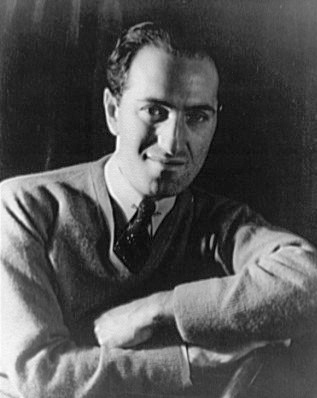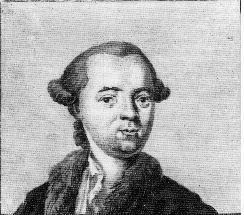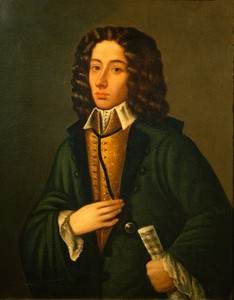
George Gershwin |
George Gershwin
What does his music say? About ordinary people, about their joys and sorrows, about their love, about their life. That’s why his music is truly national… D. Shostakovich
One of the most interesting chapters in the history of music is associated with the name of the American composer and pianist J. Gershwin. The formation and flourishing of his work coincided with the “Jazz Age” – as he called the era of the 20-30s. XNUMXth century in the USA, the largest American writer S. Fitzgerald. This art had a fundamental influence on the composer, who sought to express in music the spirit of his time, the characteristic features of the life of the American people. Gershwin considered jazz to be folk music. “I hear in it the musical kaleidoscope of America – our huge bubbling cauldron, our … national life pulse, our songs …” the composer wrote.
The son of an emigrant from Russia, Gershwin was born in New York. His childhood was spent in one of the districts of the city – the East Side, where his father was the owner of a small restaurant. Mischievous and noisy, desperately playing pranks in the company of his peers, George did not give his parents a reason to consider himself a musically gifted child. Everything changed when I bought a piano for my older brother. Rare music lessons from various teachers and, most importantly, independent many hours of improvisation determined the final choice of Gershwin. His career began in the music store of the music publishing company Remmik and Company. Here, against the wishes of his parents, at the age of sixteen he began working as a music salesman-advertiser. “Every day at nine o’clock I was already sitting at the piano in the store, playing popular tunes for everyone who came …” Gershwin recalled. Performing the popular melodies of E. Berlin, J. Kern and others in the service, Gershwin himself passionately dreamed of doing creative work. The debut of the songs of the eighteen-year-old musician on the stage of Broadway marked the beginning of his composer’s triumph. Over the next 8 years alone, he created music for more than 40 performances, 16 of which were real musical comedies. Already in the early 20s. Gershwin is one of the most popular composers in America and then in Europe. However, his creative temperament turned out to be cramped only within the framework of pop music and operetta. Gershwin dreamed of becoming, in his own words, a “real composer” who mastered all genres, all the fullness of the technique for creating large-scale works.
Gershwin did not receive a systematic musical education, and he owed all his achievements in the field of composition to self-education and exactingness to himself, combined with an irrepressible interest in the largest musical phenomena of his time. Being already a world-famous composer, he did not hesitate to ask M. Ravel, I. Stravinsky, A. Schoenberg to study composition and instrumentation. A first-rate virtuoso pianist, Gershwin continued to take piano lessons from the famous American teacher E. Hutcheson for a long time.
In 1924, one of the composer’s best works, Rhapsody in the Blues Style, was performed for piano and symphony orchestra. The piano part was played by the author. The new work aroused great interest in the American musical community. The premiere of “Rhapsody”, which was a huge success, was attended by S. Rachmaninov, F. Kreisler, J. Heifetz, L. Stokowski and others.
Following the “Rhapsody” appear: Piano Concerto (1925), orchestral program work “An American in Paris” (1928), Second Rhapsody for piano and orchestra (1931), “Cuban Overture” (1932). In these compositions, the combination of the traditions of Negro jazz, African-American folklore, Broadway pop music with the forms and genres of European musical classics found a full-blooded and organic embodiment, defining the main stylistic feature of Gershwin’s music.
One of the significant events for the composer was a visit to Europe (1928) and meetings with M. Ravel, D. Milhaud, J. Auric, F. Poulenc, S. Prokofiev in France, E. Kshenec, A. Berg, F. Lehar, and Kalman in Vienna.
Along with symphonic music, Gershwin works with passion in the cinema. In the 30s. he periodically lives for long periods in California, where he writes music for several films. At the same time, the composer again turns to theatrical genres. Among the works created during this period are the music for the satirical play I Sing About You (1931) and Gershwin’s Swan Song – the opera Porgy and Bess (1935). The music of the opera is filled with expressiveness, the beauty of the intonations of Negro songs, sharp humor, and sometimes even the grotesque, and is saturated with the original element of jazz.
Gershwin’s work was highly appreciated by contemporary music critics. One of its largest representatives, V. Damrosh, wrote: “Many composers walked around jazz like a cat around a bowl of hot soup, waiting for it to cool down a bit … George Gershwin … was able to perform a miracle. He is the prince who, taking Cinderella by the hand, openly announced her to the whole world as a princess, much to the fury of her envious sisters.
I. Vetlitsyna





